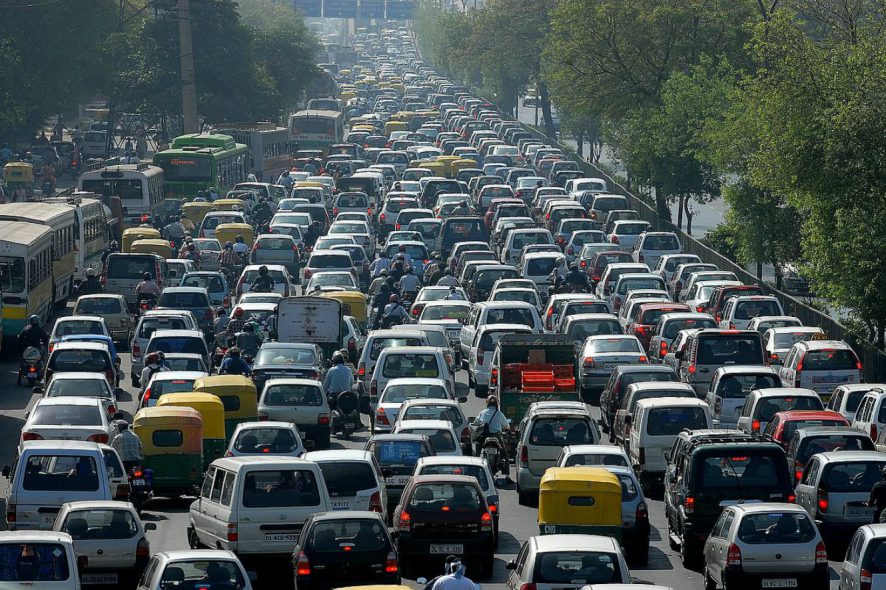A paradigm shift in transport planning and policy interventions has been called by a high powered Committee on ‘Decongestion of Traffic in Delhi’ to check explosive growth in automobile population in the national capital and move people more efficiently than cars through effective public transport system. The Committee was set up by the Minister of Urban Development Shri M.Venkaiah Naidu in October, 2014 on the havoc being caused by traffic congestion came out with a 126 page comprehensive report analyzing the causes and consequences of traffic congestion and suggesting a way forward.
The Committee strongly recommended development of necessary infrastructure for promoting walking and cycling in the national capital. It also opined that automobile centric planning with focus on road widening, construction of more and more flyovers, Foot Over Bridges, Under Passes etc., have only promoted increased use of private vehicles which are meeting only less than 20% of transport needs and should not be encouraged unless warranted by natural barriers like rivers. The Committee called for various interventions over the next five years to enable 80% share for public transport and non-motorised trips in total transportation in the city where in the total passenger trips are estimated to increase to 280 lakhs per day in 2021 from a mere 45 lakh trips in 1981, 118 lakh trips in 2001 and 144 lakhs in 2008.
To ensure a safe, sustainable, affordable, equitable, comfortable, accessible and environmental friendly public transport system in the city, the Committee recommended a four pronged strategy with the components of :
- Improving Public Transport and Disincentivising use of private vehicles;
- Promoting Road Safety and efficient Traffic Management;
- Setting up Unified Metropolitan Transport Authority and enhancing institutional capacity; and
- Promotion of Transit Oriented Development through integrated land use and transportation planning.
The recommendations of the Committee under these 4 components of the Strategy include:
- Fully paid rented or owned parking with parking fee based on area of the city, duration and size of the vehicles;
- Parking on footpaths to be made cognizable offence under Delhi Municipal Corporation Act;
- Penal charges for parking violations to be 10 times the normal rates;
- Parking Management Districts to be planned for all public places and one agency/operator to handle both on street and off-street parking for better management;
- No stand alone parking slots to be developed;
- Shared parking to be promoted for effective use of parking sites during different periods of the day;
- Promotion of feeders services and bringing informal feeder services under legal framework;
- Mandatory provision of footpaths on all roads as per codes with right of first use of street space to pedestrians;
- Provision of more crossings for pedestrians and cyclists, at least at every 250 metres;
- Signal free corridors to be avoided as they invite more private vehicles on to roads;
- More secondary street networks to be created by avoiding creation of gated communities for providing shortcuts to pedestrians.
- Access to bus service should be within walking distance from home or office;
- Bus fares should be priced less than per/Km cost of running a two wheeler;
- Multi-level bus parking to be provided at all depots; Multi-modal, multi-use bus depots on PPP basis to be taken up for high class services and terminal experience for passengers;
- For Delhi, 2,000 buses should be procured immediately and 4,000 in the next phase;
- Intelligent Transport System be adopted for surveillance, automatic vehicle location, public information, Red Light Camera and Stop Line Violation Detection, Automatic Number Plate Recognition, Automatic Parking Management and Intelligent Signaling for synchronized movement of vehicles across different signal etc.
- Operational Control Centre to be set up for real time monitoring and management of traffic on all roads and sharing actionable information to different service providers including Delhi Police for automatic issue of challans for violations;
- Effective traffic management through better traffic dispersal by enabling more junctions, junction improvement, provision of roundabouts, removal of choke points, segregation of long haul and short haul traffic, promotion of secondary road networks;
- Commissioning a Freight Audit of the city based on analysis of consumption behaviors of citizens and availability of key supplies and movement of goods for evolving a Freight Plan for the city.
- Engaging high quality professionals for in-house technical assistance for better planning and execution of projects;
- Preparation of comprehensive and integrated Land Use Transport System on priority basis;
- Improving regional connectivity through integrated Regional Rapid Transport Systems; ensuring full utilization of Sub-urban ring rail system including for freight movement and decongestion at major railways station;
- Enabling quick start of Transit Oriented Development Projects (TOD) for reducing mobility needs and enabling access to public transport for long distance travel;
- Development of BRTS corridors on high density routes; and
- Creation of Urban Transport Fund for Delhi for tapping various revenue streams like parking charges, fuel taxes, advertisement incomes etc., for augmenting bus services.
Press Information Bureau
Picture Credits: Sanjevani.com







… [Trackback]
[…] Read More: blog.scconline.com/post/2016/06/06/committee-on-decongestion-of-delhi-traffic-recommends-better-use-of-existing-road-space-multi-modal-integration/ […]